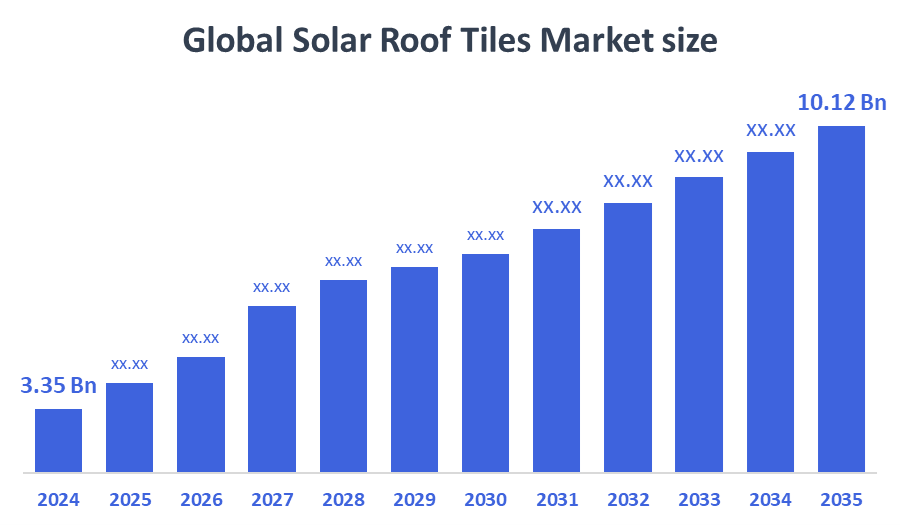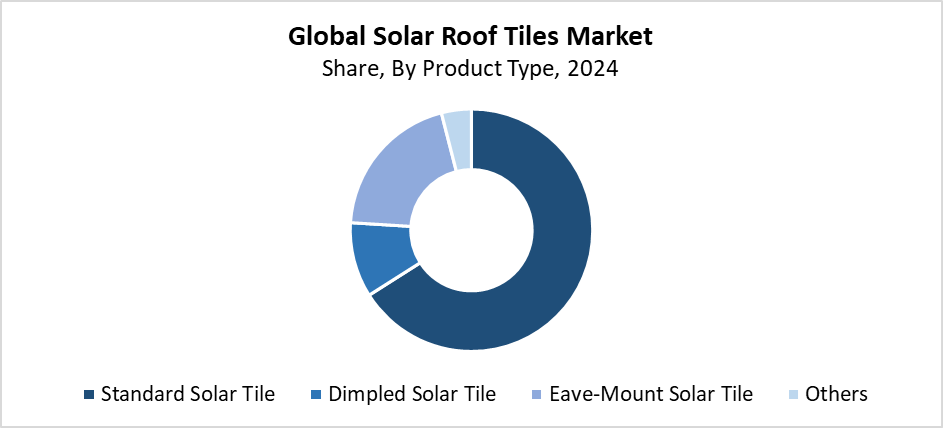Global Solar Roof Tiles Market
Global Solar Roof Tiles Market Size, Share, and COVID-19 Impact Analysis, By Product Type (Standard Solar Tile, Dimpled Solar Tile, Eave-Mount Solar Tile, Others), By End Use (Residential, Non-residential), and By Region (North America, Europe, Asia-Pacific, Latin America, Middle East, and Africa), Analysis and Forecast 2025 - 2035
Report Overview
Table of Contents
Solar Roof Tiles Market Summary
The Global Solar Roof Tiles Market Size Was Estimated at USD 3.25 Billion in 2024 and is Projected to Reach USD 10.12 Billion by 2035, Growing at a CAGR of 10.88% from 2025 to 2035. The market for solar roof tiles is expanding because of the growing need for solar solutions that are visually pleasing, the increased emphasis on environmentally friendly construction materials, government clean energy subsidies, improvements in photovoltaic technology, and the expanding use of energy-efficient, smart home systems.

Key Regional and Segment-Wise Insights
- In 2024, North America held the biggest revenue share of 31.6%, dominating the market for solar roof tiles globally.
- In 2024, the standard solar tile segment had the highest revenue share of 66.3% and led the market by product type.
- In 2024, the residential segment had the highest revenue share of 59.7% and led the market by end use.
Global Market Forecast and Revenue Outlook
- 2024 Market Size: USD 3.25 Billion
- 2035 Projected Market Size: USD 10.12 Billion
- CAGR (2025-2035): 10.88%
- North America: Largest Market in 2024
The market for solar roof tiles operates through the business activities that sell photovoltaic (PV) tiles, which function as conventional roofing materials while generating electrical power from sunlight. Solar roof tiles offer a dual advantage of aesthetic appeal and energy generation because they merge with the appearance of traditional roofs better than standard solar panels. The industry grows because sustainable architecture gets more popular while people want clean energy, and grid electricity costs keep going up. Solar tiles attract homeowners and developers because they combine modern design elements with operational functionality. This makes them ideal for building new homes and replacing roofs. The global push for energy independence and carbon neutrality drives higher adoption rates for building-integrated photovoltaics (BIPV), which includes solar tiles as fundamental elements.
Technological advancements have led to major progress in both the performance and visual appeal of solar roof tiles. The development of thin-film solar cells and monocrystalline silicon technology, together with durable weather-resistant materials, has created modern solar tiles that perform better while being lightweight and lasting longer. The present market offers systems with smart inverters, energy storage units, and financial aid programs to help users maximise their self-consumption while achieving independence from the power grid. The governments of various regions support market growth through their implementation of tax incentives, green construction rules, and solar requirements. The worldwide solar roof tile market will continue to grow because people understand environmental issues better, as technology advances, and these activities continue to develop.
Product Type Insights

The standard solar tile segment holds the largest market share of 66.3% and led the solar roof tiles market in 2024. These tiles are popular because they are affordable, simple to install, and work with a variety of roofing systems. Standard solar tiles function as an excellent solution for houses which need both functional and aesthetic elements because they integrate seamlessly with traditional roofing materials while producing solar power. Their dominance in the market is a result of their extensive use in residential and small commercial buildings, particularly in new construction and roof replacement projects. The global market position of conventional solar tiles has become stronger because of better long-lasting materials and improved solar cell efficiency. This extends product lifespan and performance.
The eave-mount solar tile segment of the solar roof tiles market is expected to grow at the fastest CAGR during the forecast period because its innovative design allows for straightforward installation with existing roofing systems. Eave-mount solar tiles function as a suitable choice because they mount at the roof edge, which maintains the original roofing material, while regular solar tiles need to replace the entire roof surface. The market has become popular among builders and homeowners who want to boost solar power production while protecting their roof structure from harm. The adoption of technology has increased because of advancements which make tiles more durable and efficient. They simplify their modular installation process. Space-efficient solar solutions find their way into the market because people realise the benefits of building-integrated photovoltaics (BIPV), which have become more popular recently.
End Use Insights
The residential segment leads the solar roof tiles market with the largest revenue share of 59.7% in 2024. The market leads because homeowners want roofing solutions that combine attractive looks with energy efficiency to reduce both their carbon emissions and their utility costs. Solar roof tiles attract modern home designs and upscale residential buildings because they provide an elegant and integrated alternative to standard solar panels. The residential sector continues to grow because of government programs which provide financial incentives and tax breaks, and net metering policies. Consumer confidence has grown as solar tile technology has advanced into weather-resistant and long-lasting solutions. People now understand better about sustainable practices. The residential segment drives market growth because of these combined factors.
The non-residential segment of the solar roof tiles market is expected to grow at the fastest CAGR during the forecast period because commercial, industrial, and institutional buildings continue to adopt sustainable energy solutions. Solar roof tiles serve as an investment for companies and real estate developers because they enable long-term energy cost reduction, green building certification, and environmental standards compliance. Solar tiles provide a dual benefit because they create environmentally friendly power while maintaining building aesthetics. Public institutions, retail businesses, and commercial properties need. The combination of better energy storage systems and building-integrated photovoltaic (BIPV) technology results in higher system efficiency and better return on investment. The sector experiences accelerated market growth because organisations pursue sustainability and government institutions establish supportive policies.
Regional Insights
North America led the global market for solar roof tiles by holding the largest revenue share of 31.6% in 2024 through its extensive solar tile usage across the United States and Canada. The region benefits from net metering programs and state-level incentives and federal tax credits, which have helped drive up the number of residential and commercial solar installations. Solar roof tiles have gained popularity because people want solar solutions that look good, and because of increasing awareness about sustainable building methods and rising electricity prices. The market benefits from better product availability and pricing because major solar manufacturers and homebuilders invest more funds into photovoltaic technology development. North America continues to lead in the adoption and innovation of solar roof tiles as consumers place a high value on both design and energy efficiency.
Asia Pacific Solar Roof Tiles Market Trends
The Asia Pacific solar roof tiles market experiences substantial growth because of urban growth, rising renewable energy funding, and strong governmental support for eco-friendly infrastructure. The nations of China, Japan, South Korea, and India adopt these initiatives because of growing energy needs and their commitment to environmental protection and sustainable construction practices. The region selects solar roof tiles for residential and commercial purposes because solar energy is abundant, while solar technology prices continue to drop. The government backs rooftop solar adoption through its provision of feed-in tariffs, tax incentives, and financial support programs. The industry expansion benefits from smart energy systems and building-integrated photovoltaic (BIPV) technology development.
Europe Solar Roof Tiles Market Trends
The European solar roof tile market experiences significant growth because energy costs rise while consumers want attractive solar systems, and companies pursue carbon neutrality. Germany, together with France, the Netherlands, and the UK, established legal frameworks which promote renewable energy through feed-in tariffs and tax incentives. These include mandatory energy efficiency standards for new buildings. The demand for solar roof tiles continues to rise because builders focus on nZEB construction, and architects choose sustainable design practices. The development of new installation practices and thin-film and monocrystalline technology advancements results in better product acceptance and improved performance. The European market stands as a vital growth opportunity because it maintains sustainable practices and favourable business regulations.
Key Solar Roof Tiles Companies:
The following are the leading companies in the solar roof tiles market. These companies collectively hold the largest market share and dictate industry trends.
- Tesla
- Onyx Solar
- Meyer Burger Technology AG
- Anu Solar Power Pvt Ltd
- Targray
- Solarstone
- Roofit.Solar
- SunRoof International Holding AB
- SANGOBUILD
- TOENERGY
- Others
Recent Developments
- In November 2024, to boost efficiency, Solarstone installed a robot-powered automated production line in Viljandi (3 KUKA KR 120) to produce up to ~150,000 integrated solar panels annually.
- In November 2024, Onyx Solar introduced glass-glass walkable PV tiles that may be used on patios, decks, roofs, and other surfaces. These tiles can support a pedestrian loading of around 400 kg/m², include anti-slip safety glass, and have a nominal capacity of about 75 W.
Market Segment
This study forecasts revenue at global, regional, and country levels from 2020 to 2035. Decision Advisors has segmented the solar roof tiles market based on the below-mentioned segments:
Global Solar Roof Tiles Market, By Product Type
- Standard Solar Tile
- Dimpled Solar Tile
- Eave-Mount Solar Tile
- Others
Global Solar Roof Tiles Market, By End Use
- Residential
- Non-residential
Global Solar Roof Tiles Market, By Regional Analysis
- North America
- US
- Canada
- Mexico
- Europe
- Germany
- UK
- France
- Italy
- Spain
- Russia
- Rest of Europe
- Asia Pacific
- China
- Japan
- India
- South Korea
- Australia
- Rest of Asia Pacific
- South America
- Brazil
- Argentina
- Rest of South America
- Middle East & Africa
- UAE
- Saudi Arabia
- Qatar
- South Africa
- Rest of the Middle East & Africa
Check Licence
Choose the plan that fits you best: Single User, Multi-User, or Enterprise solutions tailored for your needs.
We Have You Covered
- 24/7 Analyst Support
- Clients Across the Globe
- Tailored Insights
- Technology Tracking
- Competitive Intelligence
- Custom Research
- Syndicated Market Studies
- Market Overview
- Market Segmentation
- Growth Drivers
- Market Opportunities
- Regulatory Insights
- Innovation & Sustainability
Report Details
| Pages | 240 |
| Delivery | PDF & Excel via Email |
| Language | English |
| Release | Oct 2025 |
| Access | Download from this page |
